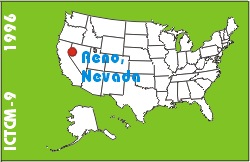
Electronic Proceedings of the Ninth Annual International Conference on Technology in Collegiate MathematicsReno, Nevada, November 7-10, 1996Paper C046Teaching Ordinary Differential Equations with Computer Experiments (In a Third World Country) |
Samer HabreLebanese American University Beirut, Lebanon Phone: (00961) 01-867099x297 shabre@lau.edu.lb list of all papers by this author |
Additional file(s) associated with this paper:
|
ABSTRACT
This paper is the outcome of an experiment on computers and the teaching of ordinary differential equations conducted in the Spring of 1995 at the Lebanese American University in Beirut, Lebanon. The majority of the students were future engineers with very few of them majoring in Computer Science and in Mathematics Education. The objective of the experiment was to integrate Mathematica and in few examples MacMath into the course content as an approach to create a novel way for teaching ODE's, clarifying concepts otherwise difficult to present on the board. Other objectives were to assess changes to the course content and to introduce the computer to a society that is still somehow computer illiterate at large.A principal goal of education is to empower students by providing them with the tools of learning. This was a main reason lying behind this experiment for which I had prepared a 'Laboratory Workbook' to come as a supplement to the book adopted for use in our ODE class. Many difficulties were faced in the implementation, the main problem being the limited availability of computers. The experiment had its successes and its failures depending on the material discussed and on the level of my preparation as a lab instructor.
In this paper I choose to present some of the successes of the experiment, such as using MacMath to understand the direction field and using Mathematica to minimize the calculations involved in solving homogeneous and non-homogeneous higher order ODE's. Mathematica was also used to understand the problems of Springs motion and for finding series solutions of ODE's. Furthermore, the results of a questionnaire that was distributed to the 26 students of the class is presented. The results show some weaknesses in the experiment, however, the experiment was rated as somehow successful and the instructor was encouraged to improve it and repeat it in the future.
Keyword(s): differential equations, Mathematica
